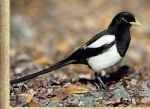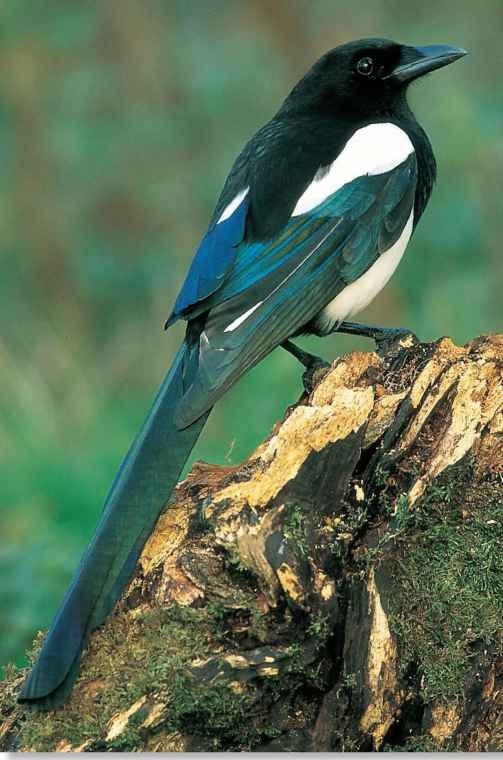ORDER
Passeriform.es
FAMILY
Corvidae
GENUS & SPECIES
key features
• Notorious as a thief of shiny objects and a raider of other birds’ nests; the subject of more superstitions than any other bird
• Unmistakable black and white plumage makes it one of the easiest birds to identify
• An intelligent opportunist that has
extended its range into the modern urban and suburban environment
where in the world?
Occupies an enormous range from Europe and northwest Africa, across central Asia, into northeastern Asia; also along the west coast of North America, from Alaska to California, into the Midwest
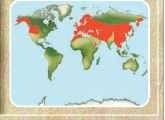
LIFECYCLE
Widely reviled as a killer — although it takes far fewer birds than hawks — and feared by others as unlucky, the clever and resourceful magpie still holds a fascination for us.
HABITAT
Once a bird of light woodland and field edges, the magpie avoids both dense woodlands and wholly treeless areas.
Urban parks and gardens, with trees, shrubs and open patches of grass, are ideal habitats for the magpie, which has been swift to exploit these new oppor tunities. Its bold, inquisitive nature and ability to take advantage of a wide range of foods have enabled it to thrive in the suburbs, despite its widespread unpopularity.
CONSERVATION
The magpie has long been persecuted by gamekeepers, who see it as a threat to the nests of gamebirds such as the pheasant. On ranchlands in the west, the birds will feed on dead cattle and sheep.This has proved lethal when the carcass has been poisoned to kill marauding coyotes. The magpies ate the poisoned meat and whole families of birds were lost. However, it is an adaptable species and continues to be numerous.

A Park life
Magpie colonies occur in parks, even in large cities.
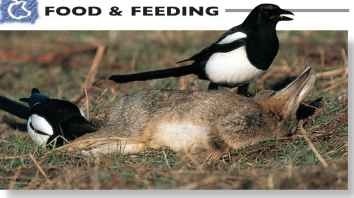
A Dead, easy meal Like members of the crow family, the magpie takes advantage of carrion.
The magpie is notorious as a raider of other birds’ nests and can occasionally be seen taking juveniles or even the adults of small species from the air It is known to track down nest sites by watching target birds, such as the thrush. But this potentially rich food source is available only part of the year; and makes up less than 1% of the magpie’s diet.
For most of the year; the magpie eats invertebrates, which it uncovers by scratching among leaf litter or in loose soil. It also regularly feeds on seeds, fruits and carrion. As this clever and resourceful species has made its way into the suburban landscape, it has learned to find many new sources of food, from overturned refuse bins to doorstep milk bottles.
BEHAVIOR
Although usually seen singly or in pairs, the magpie has a complex set of social relationships. A pair occupies a territory during the breeding season, which it defends from other pairs. If the territory is particularly rich, the pair remains all year ’round, but otherwise joins temporary winter flocks that roost communally during the coldest months.Young males without a mate may form flocks at any time of the year.
In early spring, the magpie may exhibit a form of communal behavior that has puzzled ornithologists for years. Flocks of up to 200 birds gather and, amid much excited chattering, make extravagant displays of flying skills, preening and posturing to one another. This behavior has been described as the “magpie parliament” or “crow marriage” and was thought to be an arena in which individuals chose mates. But studies have shown that many birds attending are already paired. Another theory is that the event is part of a process that establishes a hierarchy among the local population. This hierarchy may decide which pairs get the best territories.
breeding
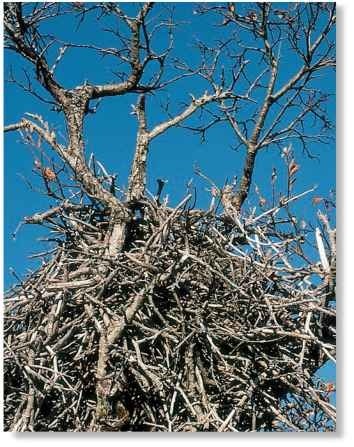
The magpie’s name comes from the name Maggie, a traditional nickname for a chattering woman, and “pied,” referring to the bold plumage pattern.
# The magpie’s thieving habits are notorious worldwide; the Kashmir subspecies is known as dudz, meaning thief.
# In many cultures, there is a superstition that anybody encountering a magpie must make a sign to ward off the bad luck the bird brings. In Norway, however, the bird is seen as a good omen.
Mating pairs of magpies form when roosting flocks gather during winter Pairs generally remain together for life. Establishing a territory early in the spring, each pair builds a nest before mid-April — the peak laying period.
The magpie’s nest is a large, untidy robust structure often built high up in a tree.Thorn trees are the preferred site since they offer some defense from predators, but, failing this, the magpie often incorporates thorny branches into a protective domed roof.Inside the nest, a basin of hardened mud lined with feathers, grass or other soft material holds the eggs.
A Summer house
A mating pair often returns yearly to a favored nest.
Sun worshipper The magpie, like other birds, sunbathes, using the natural warmth to help “iron out” kinks in its feathers.
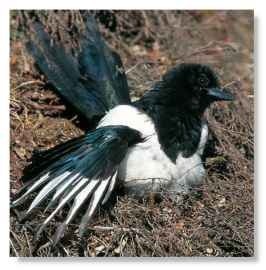
family way

1 Preparing…
The male and female magpie cooperate in constructing a nest.The male collects material and brings it to the female.
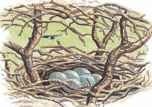
2 Expecting…
The female constructs the large, domed structure and, when it is finished and lined with mud and grass, she lays her clutch of eggs.
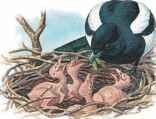
3 Feeding…
Once the nestlings hatch, both parents feed the brood for 3—4 weeks in the nest and for another 6—8 weeks afterward.
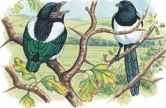
4 Fly the nest
Some families stay together in their territory until the start of winter, but the juveniles have to gather food for themselves.
PROFILE
Black-billed Magpie
The magpie’s short wings and long, fanning tail are adaptations to a habitat very different to the one it has colonized in recent years.
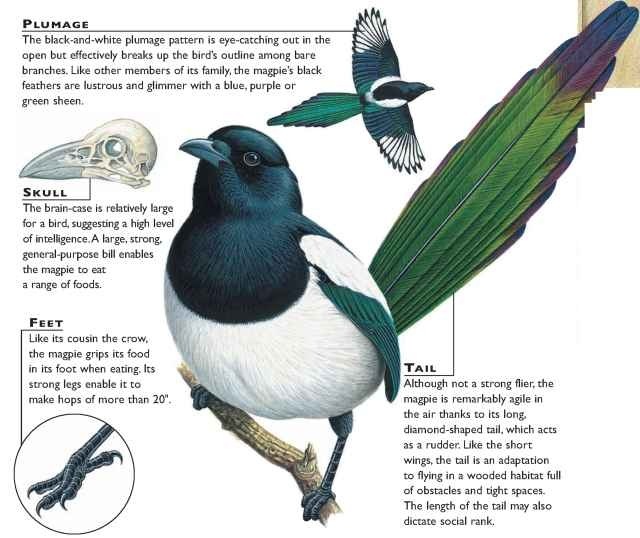
CREATURE COMPARISONS
The azure-winged magpie (Cyanopica cyana), about a third smaller than the black-billed magpie, is a very handsome bird with a black cap, white throat and sky-blue wings. Found in small, isolated populations across southern Eurasia from Spain to Mongolia and Japan, the azure-winged magpie may have once occupied a continuous
range across Azure-winged magpie

this entire region.The azure-winged magpie relies more on the flock than does its relative, banding together for the whole year and defending a communal territory. Both species favor a lightly wooded habitat, but the azure-winged magpie likes to nest on riverside debris.
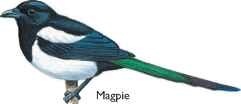
| vital statistics | Weight 6.5-9.5 oz. |
Length
16-18.5″ including tail
| WWlNGSPAN 21-24″ | |
| Breeding , Season |
Mid-March |
| : Number [ of Eggs | 5-8 |
| Incubation Period | 17-18 days |
| Fledging Period | 22-27 days |
| Breeding Interval | 1 year |
| Typical Diet | Invertebrates, seeds, fruit, carrion |
| Lifespan | 10 years |
Related species
• There are 12 other species in the genus Pica, including the North American yellow-billed magpie, P. nuttalli (below), found only in California. They are among 115 species in the family Corvidae, which includes the crow, jay and raven.
